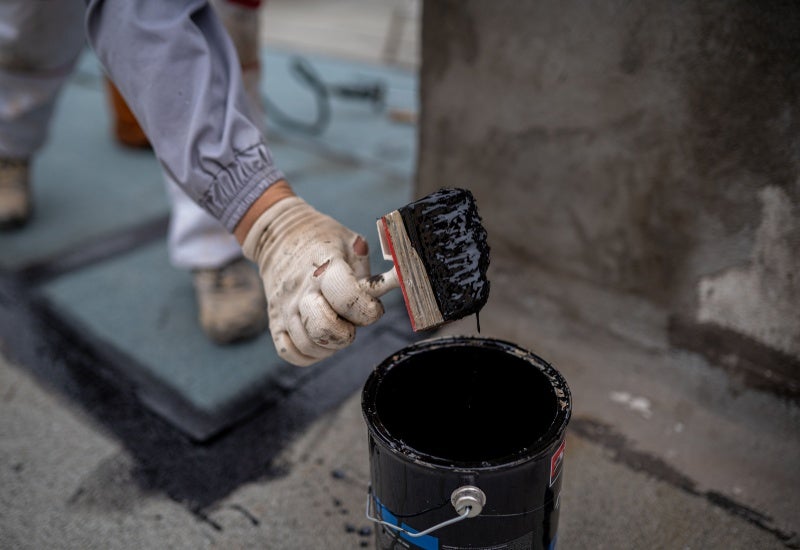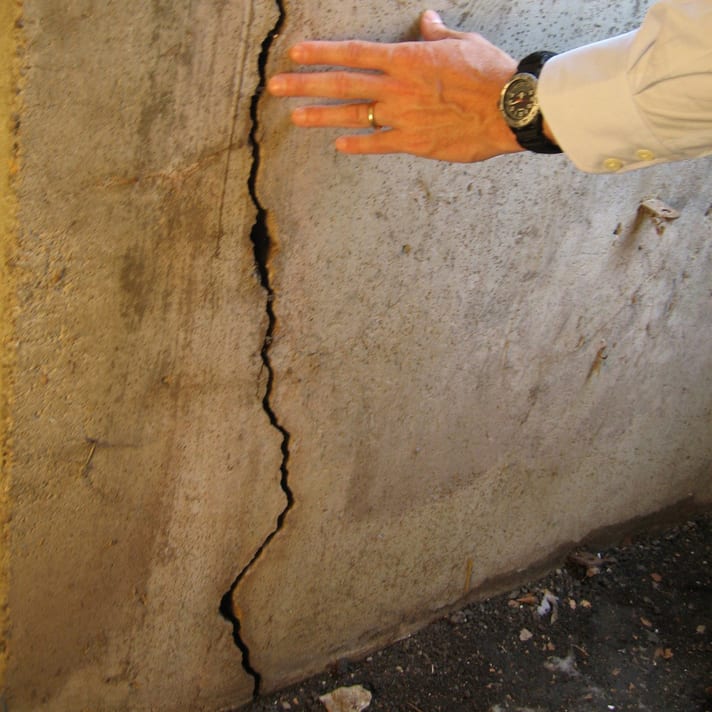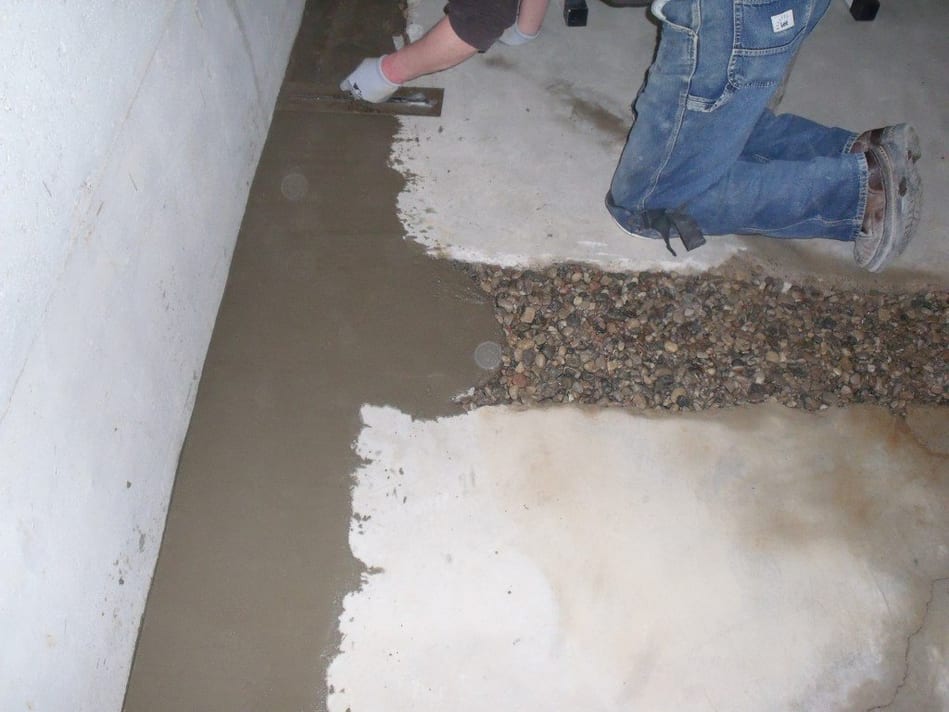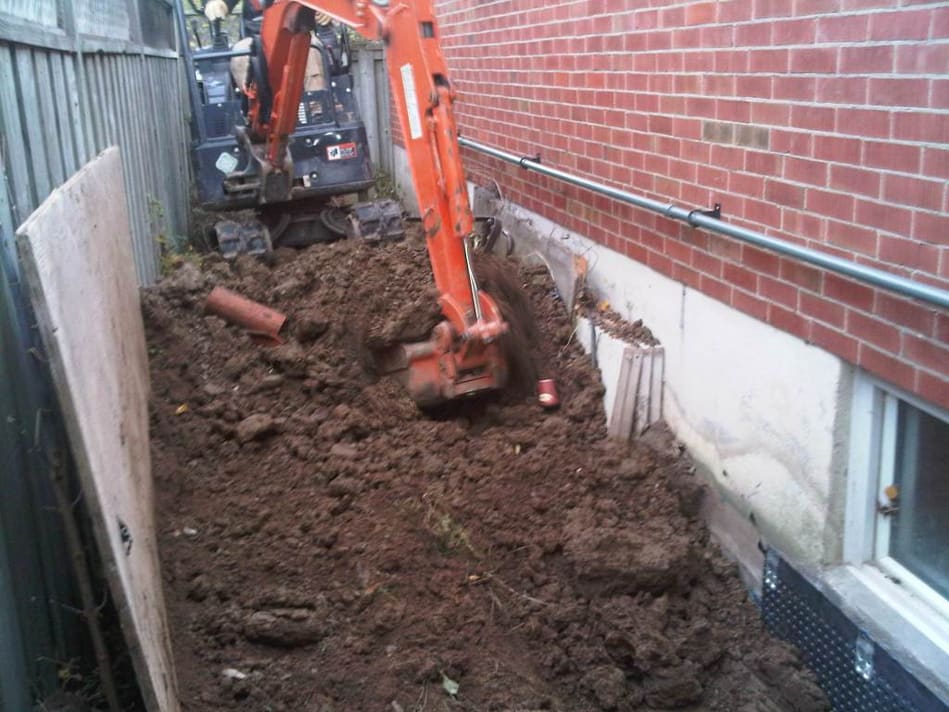-
Is Interior Waterproofing Different from Exterior Waterproofing?
Is Interior Waterproofing Different from Exterior Waterproofing?
At Triad Basement Waterproofing, we know that managing moisture and preventing water damage is key to maintaining the structural integrity of a building. In areas prone to heavy rain or where basements are below the water table, waterproofing can be especially important. Our professionals have been helping to repair and protect homes from water intrusion and damage since 1987, and today we want to help you learn more about the processes involved in waterproofing. Generally, we can divide the procedure into two categories: interior and exterior. Each method addresses different issues and offers unique benefits and challenges. Today, we will explore both methods in detail, outlining their pros and cons, and distinguish between the two to help you make informed decisions.

Identifying the Problems of Basement Leak
Basement leaks can be a homeowner’s nightmare, leading to costly repairs and significant damage if not addressed properly. Common signs of basement leaks include water stains on walls and floors, musty odors, peeling paint or wallpaper, and accumulation of mold and mildew. These issues typically arise from hydrostatic pressure, which forces water through cracks in the foundation, improper drainage, or issues with the building’s construction material. Identifying the root cause of the leak is the first step towards choosing the appropriate waterproofing method.
What Is Interior Waterproofing?
Interior waterproofing involves addressing water issues from inside the basement or foundation walls. This method typically includes the installation of drain tile systems around the perimeter of the floor, a sump pump to remove water, and the application of sealants on the walls and floor. These techniques are designed to manage water that has entered the building, redirecting it away from the basement and foundation structures.
Pros & Cons of Interior Waterproofing
Pros:
- Cost-effective: Generally less expensive than exterior waterproofing as it involves less labor-intensive excavation work.
- Less intrusive: Does not require extensive landscaping or external alterations to your home.
- Quick installation: Can often be completed in less time than exterior waterproofing.
Cons:
- Reactive approach: Primarily deals with water after it has entered the structure, which can sometimes allow for moisture-related issues to persist.
- Maintenance required: Systems like sump pumps require regular maintenance and electricity to operate.
What Is Exterior Waterproofing?
Exterior waterproofing aims to prevent water from entering the home by treating the exterior walls of the basement or foundation. This method often involves excavating around the house to the full depth of the foundation walls, then applying a waterproof coating or membrane to the exterior walls and installing drainage solutions like a French drain system around the perimeter.
Pros & Cons of Exterior Waterproofing
Pros:
- Proactive solution: Prevents water from entering the structure, addressing the issue before it can cause internal damage.
- Long-term solution: Tends to last longer with less maintenance since it deals directly with external moisture.
- Increases property value: Enhances the overall health of the building structure, potentially raising property value.
Cons:
- High cost: More labor and material intensive, leading to higher costs.
- Disruptive: Requires significant excavation, which can disturb landscaping and take longer to complete.
What is the Difference Between Interior and Exterior Waterproofing Methods?
The key difference between interior and exterior waterproofing lies in their approach and the extent of their application. Interior waterproofing is designed to manage water that has already entered the building, making it a more reactive measure. In contrast, exterior waterproofing is a preventative approach, stopping water before it breaches the foundation walls.
Choosing between interior and exterior waterproofing depends on several factors, such as the severity of the water issue, the construction of the building, the local climate, and budget considerations. In some cases, a combination of both methods may be the most effective way to ensure a dry and healthy basement environment.Call Triad Basement Waterproofing
For over 30 years, Triad Basement Waterproofing has been solving moisture problems in basements across Washington D.C., Virginia, and Maryland. Our professionals are skilled at finding and fixing water leakage issues before they can grow large enough to cause problems with the structural integrity of your home. We have developed state-of-the-art solutions for basement water leakage and structural support. We also remove mold and mildew when it finds its way into your home and craft drainage solutions to make sure these issues don’t happen again. Call us now at (301) 532-7903 or visit our website at Triad Basement Waterproofing to schedule your free consultation.
-
What Causes Concrete Foundation Cracks?
What Causes Concrete Foundation Cracks?
Although our homes are built to be resilient to many things, after some time they tend to wear down. In the same way we show signs of age through wrinkles, our homes show it through imperfections and cracks. With the flaws of imperfect construction, pressure surrounding the home and the weight of the house bearing down on it, the foundation of your home takes it all. When it comes to foundation cracks or repairs, the important thing is to take care of the issue as soon as possible. It’s not a good idea to forget about it and wait until the crack gets bigger and allows water to leak into your basement and flood your home.
All concrete has the tendency to crack and there is no way to produce crack-free concrete. Concrete expands and shrinks with changes in temperature and moisture and this can cause cracking early on. Often concrete foundation cracks are not detected until long after they’ve formed. Regardless of how long the crack has been there, it tends to concern homeowners and they worry about the imperfection.
Cracks in concrete foundation most often appear at weak points like corners, basement window frames, walls and pipe areas. It’s important to keep track of these cracks and notice if they are getting bigger. It’s also important to understand why the crack showed up in the first place. What causes concrete foundation cracks? Read on to find out!

Top Causes of Concrete Foundation Cracks
Drought or too much moisture
Soil shrinks like a sponge when moisture is removed from it and when that happens it pulls away from the foundation of your home creating a gap. This gap allows for the foundation to move. When the foundation of a home is not supported properly it can shift around and cracks will begin to appear. In turn, if there is too much moisture it will cause the soil that is supporting the foundation of your home to expand.
Earthquakes
When an earthquake occurs it causes the ground to shake, which in turn shakes your home around. Thankfully not too many earthquakes occur on this side of the U.S., however even the tiniest of quivers can be an issue. Remember, if the foundation isn’t supported or stable, it can move around, weaken and crack. A small earthquake may not cause new cracks, but it can intensify ones that are already present.
Storms
Whether you experience a hurricane, a nor’easter or just a typical rainstorm these storms produce a lot of water, which can damage the foundation of your home. Too much water will force the soil around the foundation of your home to expand, which will push up against the home and cause concrete foundation cracks. Storms can also cause various other structural problems if you don’t take preventive measures to secure your home. One of the most popular explanations behind concrete foundation cracks is the freeze and thaw cycle during the winter. Concrete freezes at around 18 degrees and then it melts at around 35 degrees, which is when the cracking develops.
Plumbing Leaks
It’s important to make sure your pipes are secured and aren’t leaking and that you don’t have any plumbing leaks in your home. If you’re home isn’t equipped with basement waterproofing or a sump pump, the excess water will add to the soil causing it to expand and push against your foundation.
Flooding
Regardless of whether the flooding comes from a storm, a leak, inadequate drainage or something else, too much water will be a problem for your concrete foundation. When hydrostatic pressure becomes too much for the foundation of your home you will notice more leaks, more cracks and more problems.
Extreme Heat
Concrete can also crack under extreme sun and heat because it causes the concrete to expand. During the day and under the sun the concrete will expand, and then overnight the concrete will shrink and retreat back to its original unbaked position.
Get Help Fixing Your Cracks
The moral of the story is that it is important to keep your foundation stable, dry and supported.
When your foundation has wiggle room due to dry soil or if it’s tightly pushed in by expanding soil, these movements cause it to weaken and in turn create concrete foundation cracks. The good news is that concrete foundation cracks that are a result of too much moisture and flooding can be prevented through various methods of basement waterproofing.
It’s also not too difficult to repair concrete foundation cracks with epoxy injections. If you are thinking about preventive measures or you need concrete repair, then contact the team at Triad Basement Waterproofing and they will create a custom solution to your specific situation.
-
Top 3 Methods of Basement Waterproofing
Top 3 Methods of Basement Waterproofing
Are you suffering from a wet basement? Or are you looking for precautionary measures to help prevent basement flooding in your home?
Regardless of the motivation, it’s a good idea to invest in basement waterproofing for your home so you can protect what is yours, prevent any damages as well as save money instead of spending it on fixing a ruined basement or replacing damaged belongings.
If you are trying to figure out a way to cure a wet basement, or how to prevent one from happening then you are probably curious about the products and methods behind basement waterproofing. It is possible to dry out a basement and keep it that way with waterproofing, drainage and sealants, but you need to make sure you are choosing the right method, materials and contractors for your specific situation.
Each basement and situation is different so it is important to know where the moisture could potentially come in from and to create a comprehensive solution that is going to last. There are really only three methods to basement waterproofing – interior, exterior and drainage.
Let’s find out more about the top three methods of basement waterproofing .

Interior Sealants & Waterproofing
The most common entry point for water is through cracks in the concrete foundation. The good news is that these cracks can be easily sealed from the inside.
Special sealants are injected into the opening, penetrating through to the exterior where they seal the path off to potential moisture and leaks. These sealants usually last for a long time and come with long warranties. Although interior sealers are good for preventing leaks and humidity, they won’t work perfectly if there is strong hydrostatic pressure (water pressure) pushing against the foundation.
Using waterproof coatings on the inside of your basement is also a good idea. Concrete waterproofing coatings adhere permanently to concrete walls and work well where there is a minor dampness or condensation issue. Sealants and waterproof coatings cannot fix major leaks or basement floods.
Exterior Waterproofing
Exterior waterproofing helps to prevent water from entering your home to begin with so that the moisture doesn’t damage the foundation or the inside of your basement.
This method is accomplished by fully excavating around the home to the bottom of the foundation. Once that is done, the walls are sealed with a waterproof coating, which will waterproof the walls and direct water down to a drain system.
The drain can then be directed to a sump pump or down a slope that leads away from the foundation. This method will efficiently stop water from entering into your home and basement through the walls or through the foundation.
Interior & Exterior Drainage
If water did somehow make it into your home through a leak, then a proper drainage system is a great way to keep water under control. The easiest way to utilize drainage inside your basement is to have a sump pump that collects the water from inside and then pumps it out away from your home.
Interior drainage systems function by draining underground water from alongside the foundation of your home and then pump it away from the basement. These drainage systems should be prepared to work in case of a power outage, an overwhelming rainfall or heavy snowstorm and snow melt.
Water drainage is an efficient solution to keeping water out of your home and basement and they can also be airtight and used with vapor barriers to keep the area free from dangerous mold and mildew.

Which Method is the Best?
Nobody wants to come home to a flooded or leaky basement, so it is important to take preventive measures ahead of time and to be prepared in case a leak does occur.
There is no one best way to protect your home from leaks and moisture, because each situation is different. For some homes a coat or two of a waterproof sealant may be enough, while others may need a drainage system as well as a waterproof sealant.
When you work with Triad Basement Waterproofing, we will thoroughly analyze your basement, your foundation and your home and compose a unique solution to your issues. We not only waterproof your home, but we also make sure to relieve the water pressure from outside your home.
Apart from waterproofing your basement there are also other things you can do to help keep your home warm and dry.
Check out some of these tips to prevent a flooded basement.
We offer our professional services throughout Maryland, Pennsylvania, Virginia and Washington, DC. If you need basement help or you are thinking about basement waterproofing then contact our experts at Triad today!
